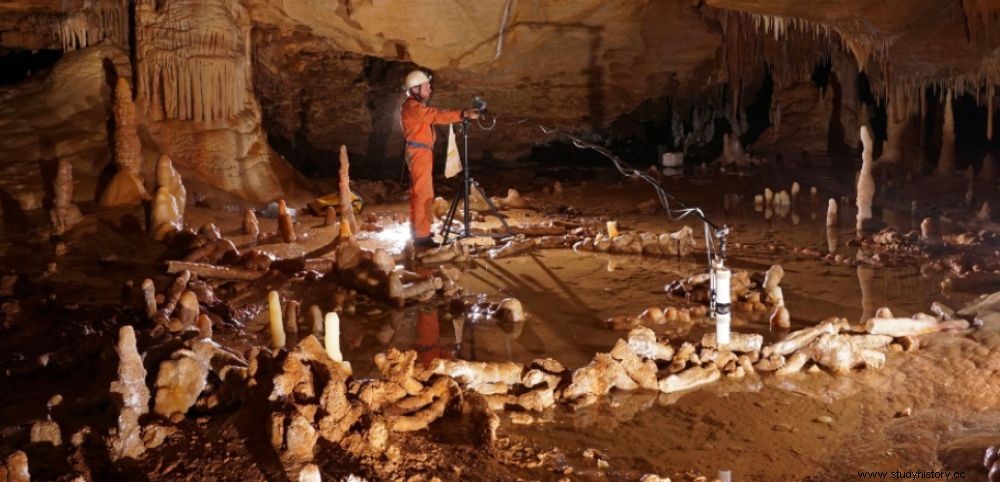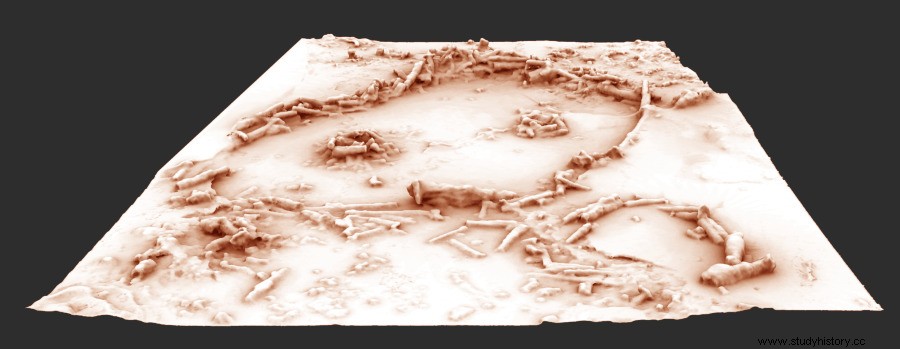 Grotto of Bruniquel (Tarn-et-Garonne), taking measurements for the archaeo-magnetic study.
Grotto of Bruniquel (Tarn-et-Garonne), taking measurements for the archaeo-magnetic study. DATING. The Bruniquel cave (Tarn-et-Garonne), a long underground gallery with majestic calcite draperies, harbored a secret! Ring structures dating back to Neanderthals (Homo neanderthalensis )! The oldest ever recorded for major works, "thus placing Bruniquel's constructions among the first in the history of humanity ". This is what has just been announced in a study by the famous journal Nature published on May 25, 2016, the prehistorian Jacques Jaubert, member of the PACEA laboratory, UMR 5199, professor at the University of Bordeaux. According to this specialist, two ovoid-shaped arrangements (2.2 x2.1 meters and 6.7 x4.5 meters) made up of 400 stalagmite elements, corresponding to more than two tons of material moved there have been dated to 176,000 years!
Homo sapiens was therefore not the only one to penetrate the bowels of the cavities
In a large room encountered 336m from the entrance to the cave, intentionally fractured crystalline concretions were laid out on the floor, forming two large annular structures and four smaller ones. However, the true age of these structures – known since the discovery of the cavity by speleologists* in 1990 – could not be established to date. Only, in 1996, a calcined bear radius bone had given a date greater than 47,600 years (the chronological limit of the use of the Carbon 14 method) to François Rouzaud and Michel Soulier. What had already intrigued these researchers. Were these creations the product of Neanderthals? Or Homo sapiens , our direct ancestors? With this age of 176,000 years obtained thanks to uranium-thorium (U-Th) dating, analyzes followed by Sophie Verheyden and Dominique Genty, the answer has just been provided. These assemblages are the unmistakable work of Neanderthals. Homo sapiens having only appeared in Europe around 40,000/45,000 years ago.

3D reconstruction of 176,000-year-old Neanderthal structures from the Bruniquel cave (Tarn-et-Garonne). © Xavier Muth-Get in Situ, Archaeotransfer, Archaeovision SHS-3D, Pascal Mora
"If we cannot establish the precise role played by these structures, their location in the depths of the cave associated with numerous traces of fire, [18 burning locations listed]indicate that their builders had more complex behaviors than those previously attributed to Neanderthals" , estimated Jacques Jaubert, joined by Sciences et Avenir .
Indeed, whether it is the remains of a refuge, a camp or achievements of a symbolic nature, the presence of these architectural arrangements in the heart of the darkness of the Bruniquel site, suggests that the first Neanderthals knew how to use fire in order to circulate in underground environments. Homo sapiens was therefore not the only one to penetrate the entrails of cavities, as was the case at Chauvet-Pont d'Arc, in Ardèche, 36,000 years ago. "This discovery of an appropriation of the underworld by Neanderthals from these very ancient periods is a real novelty. A modern behavior that seems to have emerged earlier than we thought" , said Jacques Jaubert.
* Speleo-archaeological society of Caussade
The uranium-thorium dating method makes it possible to measure the age of certain carbonate or sedimentary formations. Based on the radioactive properties of ubiquitous uranium found in small amounts in the environment.
